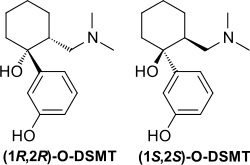Desmetramadol
 | |
| Clinical data | |
|---|---|
| Synonyms | O-Desmethyltramadol; O-DSMT; Omnitram |
| Pharmacokinetic data | |
| Metabolism | CYP3A4 and CYP2B6[1] |
| Elimination half-life | 6-8 hours |
| Identifiers | |
| |
| CAS Number | |
| PubChem CID | |
| ChemSpider | |
| UNII | |
| ChEMBL | |
| Chemical and physical data | |
| Formula | C15H23NO2 |
| Molar mass | 249.349 g/mol |
| 3D model (JSmol) | |
| |
| |
| | |
Desmetramadol (INN), also known as O-desmethyltramadol (O-DSMT), is an opioid analgesic and the main active metabolite of tramadol.[2] Tramadol is demethylated by the liver enzyme CYP2D6[3] in the same way as codeine, and so similarly to the variation in effects seen with codeine, individuals who have a less active form of CYP2D6 ("poor metabolizers") will tend to get reduced analgesic effects from tramadol. This also results in a ceiling effect (dependent on CYP2D6 availability) which limits tramadol's range of therapeutic benefits to the treatment of moderate pain.
Pharmacology
Pharmacodynamics
Desmetramadol is considerably more potent as a μ-opioid agonist compared to tramadol.[4] It also shows comparatively far lower affinity for the δ- and κ-opioid receptors.[5]
The two enantiomers of desmetramadol show quite distinct pharmacological profiles;[6] both (+) and (−)-desmetramadol are inactive as serotonin reuptake inhibitors,[7] but (−)-desmetramadol retains activity as a norepinephrine reuptake inhibitor,[8] and so the mix of both the parent compound and metabolites contributes significantly to the complex pharmacological profile of tramadol. While the multiple receptor targets can be beneficial in the treatment of pain (especially complex pain syndromes such as neuropathic pain), it increases the potential for drug interactions compared to other opioids, and may also contribute to side effects.
Desmetramadol is also an antagonist of the serotonin 5-HT2C receptor, at pharmacologically relevant concentrations.[9]
Pharmacokinetics
Metabolites
Desmetramadol is metabolized in the liver into the active metabolite N,O-didesmethyltramadol via CYP3A4 and CYP2B6. The inactive tramadol metabolite N-desmethyltramadol is metabolized into the active metabolite N,O-didesmethyltramadol by CYP2D6.
History
Development of tapentadol
The opioid medication tapentadol was developed to mimic the actions of desmetramadol in order to create a weak-moderate analgesic which is not dependent on metabolic activation. Tapentadol, however, is generally considered to be a stronger analgesic than tramadol. This may be illusory due to the metabolism-dependent effects of tramadol.
Society and culture
Recreational use
Desmetramadol has recently been marketed as a currently legal substitute for illegal opioid drugs, either in powder form or mixed into various other preparations. One such blend sold under the brand Krypton and containing powdered kratom leaf (Mitragyna speciosa) laced with desmetramadol was reportedly linked to at least 9 accidental deaths from overdose during 2010–2011.[10][11][12]
The metabolic conversion of tramadol to desmetramadol is highly dependent on individual metabolism, meaning that two users with an identical opioid tolerance can experience vastly different effects from the same dose. For this reason, tramadol is always initiated at the lowest possible dose in clinical settings and then titrated to the lowest effective dose. Recreational users tend to start with much higher doses without taking this into account, greatly increasing the risk of overdose.
Legality
United Kingdom
Desmetramadol was made a Class A drug in the United Kingdom on 26 Feb 2013.[13]
See also
References
- ↑ Tramadol Pharmacokinetics, PharmGKB
- ↑ Sevcik J, Nieber K, Driessen B, Illes P (1993). "Effects of the central analgesic tramadol and its main metabolite, O-desmethyltramadol, on rat locus coeruleus neurones". Br. J. Pharmacol. 110 (1): 169–76. doi:10.1111/j.1476-5381.1993.tb13788.x. PMC 2175982. PMID 8220877.
- ↑ Borlak J, Hermann R, Erb K, Thum T (2003). "A rapid and simple CYP2D6 genotyping assay--case study with the analgetic tramadol". Metab. Clin. Exp. 52 (11): 1439–43. doi:10.1016/s0026-0495(03)00256-7. PMID 14624403.
- ↑ Dayer P, Desmeules J, Collart L (1997). "[Pharmacology of tramadol]". Drugs (in French). 53 Suppl 2: 18–24. doi:10.2165/00003495-199700532-00006. PMID 9190321.
- ↑ Potschka H, Friderichs E, Löscher W (September 2000). "Anticonvulsant and proconvulsant effects of tramadol, its enantiomers and its M1 metabolite in the rat kindling model of epilepsy". Br. J. Pharmacol. 131 (2): 203–12. doi:10.1038/sj.bjp.0703562. PMC 1572317. PMID 10991912.
- ↑ Garrido MJ, Valle M, Campanero MA, Calvo R, Trocóniz IF (2000). "Modeling of the in vivo antinociceptive interaction between an opioid agonist, (+)-O-desmethyltramadol, and a monoamine reuptake inhibitor, (-)-O-desmethyltramadol, in rats". J. Pharmacol. Exp. Ther. 295 (1): 352–9. PMID 10992001.
- ↑ Bamigbade TA, Davidson C, Langford RM, Stamford JA (1997). "Actions of tramadol, its enantiomers and principal metabolite, O-desmethyltramadol, on serotonin (5-HT) efflux and uptake in the rat dorsal raphe nucleus". Br J Anaesth. 79 (3): 352–6. doi:10.1093/bja/79.3.352. PMID 9389855.
- ↑ Driessen B, Reimann W, Giertz H (1993). "Effects of the central analgesic tramadol on the uptake and release of noradrenaline and dopamine in vitro". Br. J. Pharmacol. 108 (3): 806–11. doi:10.1111/j.1476-5381.1993.tb12882.x. PMC 1908052. PMID 8467366.
- ↑ Horishita T, Minami K, Uezono Y, Shiraishi M, Ogata J, Okamoto T, Shigematsu A (2006). "The tramadol metabolite, O-desmethyl tramadol, inhibits 5-hydroxytryptamine type 2C receptors expressed in Xenopus Oocytes". Pharmacology. 77 (2): 93–9. doi:10.1159/000093179. PMID 16679816.
- ↑ Arndt, T; Claussen, U; Güssregen, B; Schröfel, S; Stürzer, B; Werle, A; Wolf, G (2011). "Kratom alkaloids and O-desmethyltramadol in urine of a "Krypton" herbal mixture consumer". Forensic Science International. 208 (1–3): 47–52. doi:10.1016/j.forsciint.2010.10.025. PMID 21112167.
- ↑ Bäckstrom, BG; Classon, G; Löwenhielm, P; Thelander, G (2010). "Krypton--new, deadly Internet drug. Since October 2009 have nine young persons died in Sweden". Lakartidningen. 107 (50): 3196–7. PMID 21294331.
- ↑ Kronstrand, R; Roman, M; Thelander, G; Eriksson, A (2011). "Unintentional fatal intoxications with mitragynine and O-desmethyltramadol from the herbal blend Krypton". Journal of analytical toxicology. 35 (4): 242–7. doi:10.1093/anatox/35.4.242. PMID 21513619.
- ↑ "The Misuse of Drugs (Designation) (Amendment) (England, Wales and Scotland) Order 2013". UK Home Office. 31 January 2013.